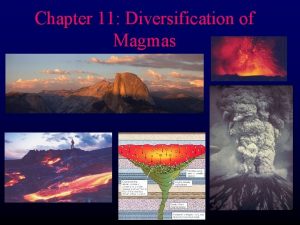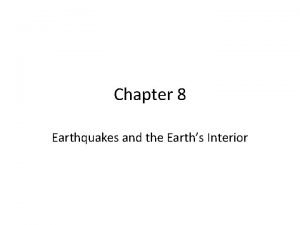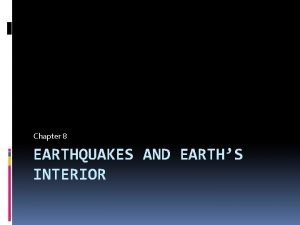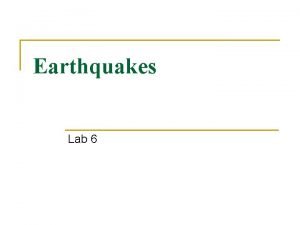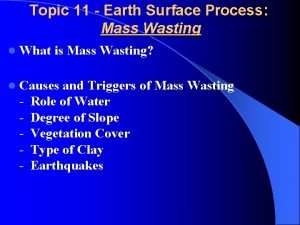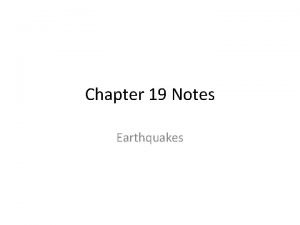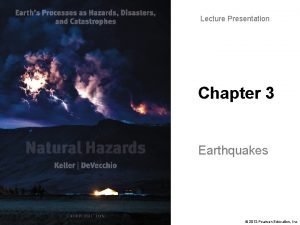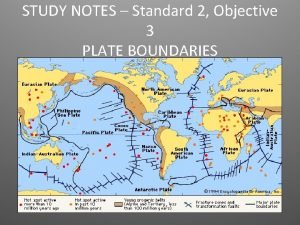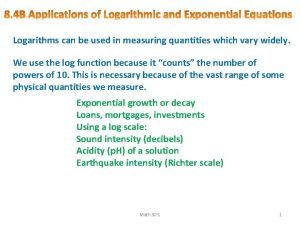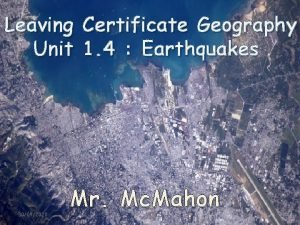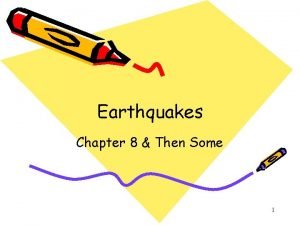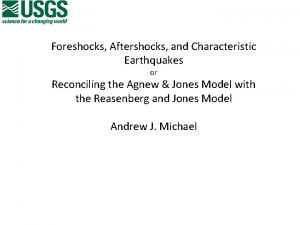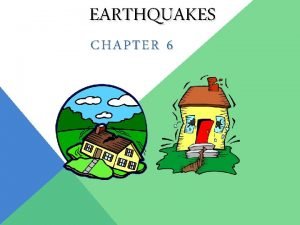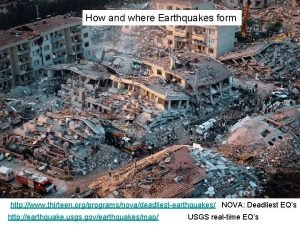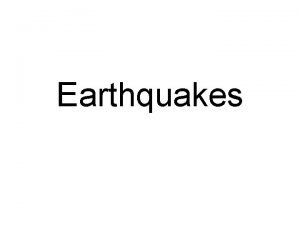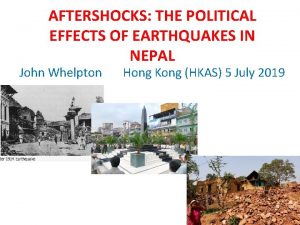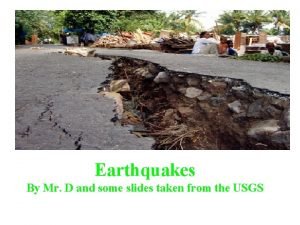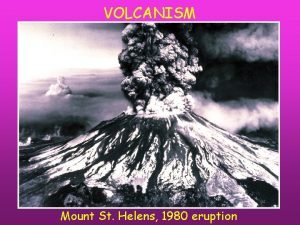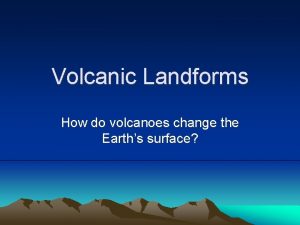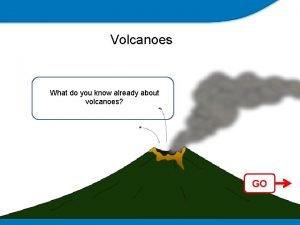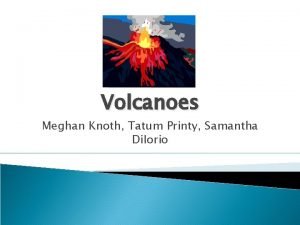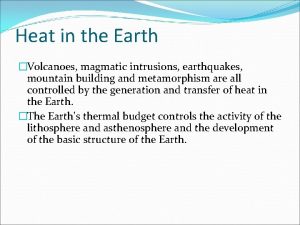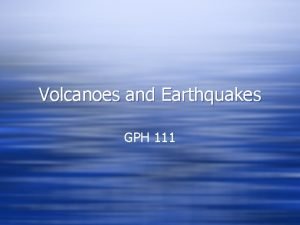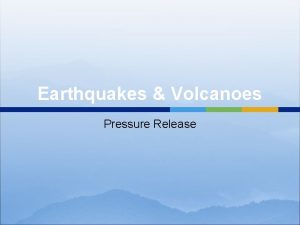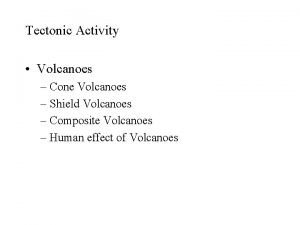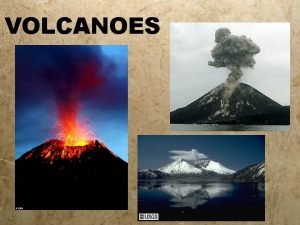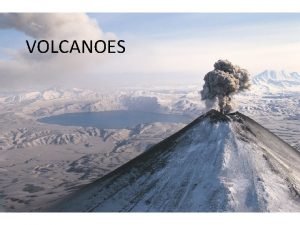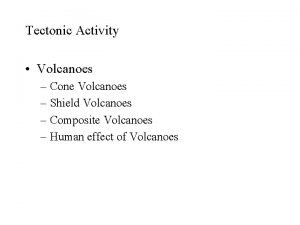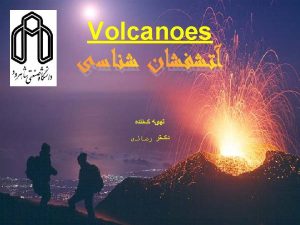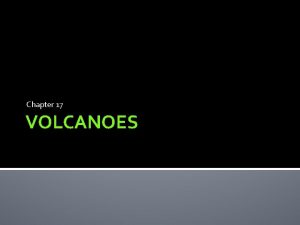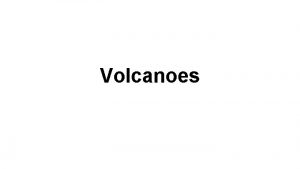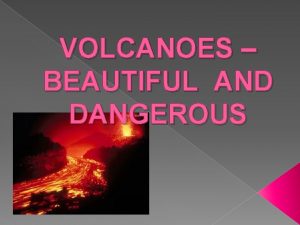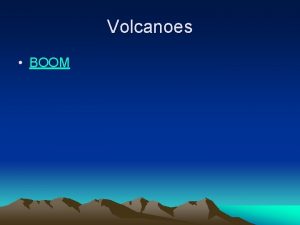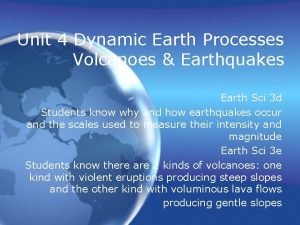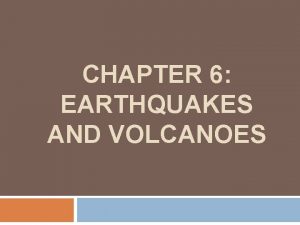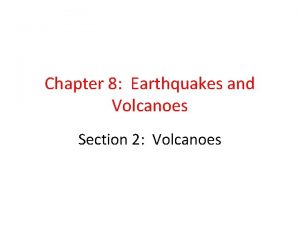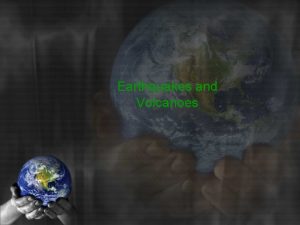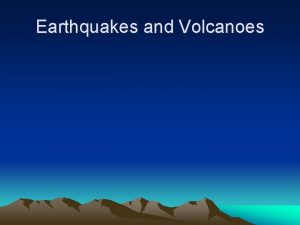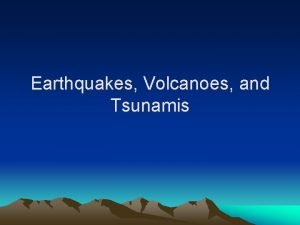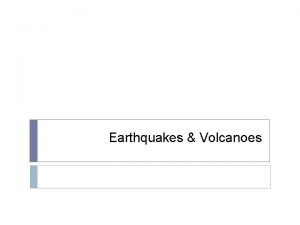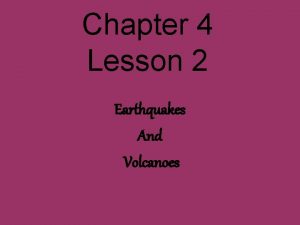Heat in the Earth Volcanoes magmatic intrusions earthquakes

































- Slides: 33

Heat in the Earth �Volcanoes, magmatic intrusions, earthquakes, mountain building and metamorphism are all controlled by the generation and transfer of heat in the Earth. �The Earth’s thermal budget controls the activity of the lithosphere and asthenosphere and the development of the basic structure of the Earth.

� Heat arrives at the surface of the Earth from its interior and from the Sun. � The heat arriving from the Sun is by far the greater of the two � Heat from the Sun arriving at the Earth is 2 x 1017 W � Averaged over the surface this is 4 x 102 W/m 2 � The heat from the interior is 4 x 1013 W and 8 x 10 -2 W/m 2 � However, most of the heat from the Sun is radiated back into space. It is important because it drives the surface water cycle, rainfall, and hence erosion. The Sun and the biosphere keep the average surface temperature in the range of stability of liquid water. � The heat from the interior of the Earth has governed the geological evolution of the Earth, controlling plate tectonics, igneous activity, metamorphism, the evolution of the core, and hence the Earth’s magnetic field.

Heat Transfer Mechanisms �Conduction � Transfer of heat through a material by atomic or molecular interaction within the material �Radiation � Direct transfer of heat as electromagnetic radiation �Convection � Transfer of heat by the movement of the molecules themselves � Advection is a special case of convection

Conductive Heat Flow �Heat flows from hot things to cold things. �The rate at which heat flows is proportional to the temperature gradient in a material �Large temperature gradient – higher heat flow �Small temperature gradient – lower heat flow

Imagine an infinitely wide and long solid plate with thickness δz. Temperature above is T + δT Temperature below is T Heat flowing down is proportional to: The rate of flow of heat per unit area up through the plate, Q, is: In the limit as δz goes to zero:

�Heat flow (or flux) Q is rate of flow of heat per unit area. � The units are watts per meter squared, W m-2 � Watt is a unit of power (amount of work done per unit time) � A watt is a joule per second � Old heat flow units, 1 hfu = 10 -6 cal cm-2 s-1 � 1 hfu = 4. 2 x 10 -2 W m-2 � Typical continental surface heat flow is 40 -80 m. W m -2 �Thermal conductivity k � The units are watts per meter per degree centigrade, W m-1 °C-1 � Old thermal conductivity units, cal cm-1 s-1 °C-1 � 0. 006 cal cm-1 s-1°C-1 = 2. 52 W m-1 °C-1 � Typical conductivity values in W m-1 °C-1 : � Silver 420 � Magnesium 160 � Glass 1. 2 � Rock 1. 7 -3. 3 � Wood 0. 1

Let’s derive a differential equation describing the conductive flow of heat Consider a small volume element of height δz and area a. Any change in the temperature of this volume in time δt depends on: 1. Net flow of heat across the element’s surface (can be in or out or both) 2. Heat generated in the element 3. Thermal capacity (specific heat) of the material

The heat per unit time entering the element across its face at z is a. Q(z). The heat per unit time leaving the element across its face at z+δz is a. Q(z+δz). Expand Q(z+δz) as Taylor series: The terms in (δz)2 and above are small and can be neglected The net change in heat in the element is (heat entering across z) minus (heat leaving across Z+δz):

Suppose heat is generated in the volume element at a rate A per unit volume per unit time. The total amount of heat generated per unit time is then A a δz Radioactivity is the prime source of heat in rocks, but other possibilities include shear heating, latent heat, and endothermic/exothermic chemical reactions. Combining this heating with the heating due to changes in heat flow in and out of the element gives us the total gain in heat per unit time (to first order in δz as: This tells us how the amount of heat in the element changes, but not how much the temperature of the element changes.

The specific heat cp of the material in the element determines the temperature increase due to a gain in heat. Specific heat is defined as the amount of heat required to raise 1 kg of material by 1 C. Specific heat is measured in units of J kg-1 C-1. If material has density ρ and specific heat cp, and undergoes a temperature increase of δT in time δt, the rate at which heat is gained is: We can equate this to the rate at which heat is gained by the element:

Simplifies to: In the limit as δt goes to zero: Several slides back we defined Q as: This is the one-dimensional heat conduction equation.

The term k/ρcp is known as thermal diffusivity κ. The thermal diffusivity expresses the ability of a material to diffuse heat by conduction. The heat conduction equation can be generalized to 3 dimensions: The symbol in the center is the gradient operator squared, aka the Laplacian operator. It is the dot product of the gradient with itself.

This simplifies in many special situations. For a steady-state situation, there is no change in temperature with time. Therefore: In the absence of heat generation, A=0: Scientists in many fields recognize this as the classic “diffusion” equation.

Talk at board about the qualitative behavior of the Heat Conduction equation

Equilibrium Geotherms �The temperature vs. depth profile in the Earth is called the geotherm. �An equilibrium geotherm is a steady state geotherm. �Therefore:

Boundary conditions �Since this is a second order differential equation, we should expect to need 2 boundary conditions to obtain a solution. �A possible pair of bc’s is: �T=0 at z=0 �Q=Q 0 at z=0 � Note: Q is being treated as positive upward and z is positive downward in this derivation.

Solution Integrate the differential equation once: Use the second bc to constrain c 1 Note: Q is being treated as positive upward and z is positive downward in this derivation. Substitute for c 1:

Solution Integrate the differential equation again: Use the first bc to constrain c 2 Substitute for c 2: Link to spreadsheet

Oceanic Heat Flow Heat flow is higher over young oceanic crust Heat flow is more scattered over young oceanic crust Oceanic crust is formed by intrusion of basaltic magma from below The fresh basalt is very permeable and the heat drives water convection Ocean crust is gradually covered by impermeable sediment and water convection ceases. Ocean crust ages as it moves away from the spreading center. It cools and it contracts.

These data have been empirically modeled in two ways: d=2. 5 + 0. 35 t 2 (0 -70 my) and d=6. 4 – 3. 2 e-t/62. 8 (35 -200 my)

Half Space Model Specified temperature at top boundary. No bottom boundary condition. Cooling and subsidence are predicted to follow square root of time. Plate Model Specified temperature at top and bottom boundaries. Cooling and subsidence are predicted to follow an exponential function of time. Roughly matches Half Space Model for first 70 my.


The model of plate cooling with age generally works for continental lithosphere, but is not very useful. Variations in heat flow in continents is controlled largely by changes in the distribution of heat generating elements and recent tectonic activity.

Range of Continental and Oceanic Geotherms in the crust and upper mantle


Convection

Conductive Geotherm ~10 -20 C per km Adiabatic Geotherm ~0. 5 -1. 0 C per km Convective Geotherm Adiabatic “middle” Thermal boundary layer at top and bottom

Solid and liquid in the Earth Illustration of mantle melting during decompression

Rayleigh-Benard Convection � Newtonian viscous fluid – stress is proportional to strain rate � A tank of fluid is heated from below and cooled from above � Initially heat is transported by conduction and there is no lateral variation � Fluid on the bottom warms and becomes less dense � When density difference becomes large enough, lateral variations appear and convection begins � The cells are 2 -D cylinders that rotate about their horizontal axes � With more heating, these cells become unstable by themselves and a second, perpendicular set forms � With more heating this planform changes to a vertical hexagonal pattern with hot material rising in the center and cool material descending around the edges � Finally, with extreme heating, the pattern becomes irregular with hot material rising randomly and vigorously.

Rayleigh-Benard Convection The stages of convection have been modeled mathematically and are characterized by a “nondimensional” number called the Rayleigh number a is the volume coefficient of thermal expansion g gravity d the thickness of the layer Q heat flow through lower boundary A, κ, k you know n is kinematic viscosity The critical value of Ra for gentle convection is about 103. The aspect ratio for R-B convection cells is about 2 -3 to 1 Ra above 105 will produce vigorous convection Ra above 106 will produce irregular convection

�Ra for both the upper and lower mantle seems to be consistent with vigorous convection �While R-B convection models are very useful, they do not approximate the Earth very well. The biggest problem is that they model “uniform viscosity” materials. The mantle is not uniform viscosity! �Reynold’s number – indicates whether flow is laminar or turbulent � All mantle convection in the Earth is predicted to be laminar �Mantle convection movies from Caltech �More mantle convection movies �More

Studies like you did in lab, seemed to show that subduction stopped at about 670 km depth. This was interpreted to mean there was mantle convection operating in the upper mantle that was separate from convection in the lower mantle. Two-layer vs. Whole Mantle Convection Modern tomographic images give a very different picture!

Plate Driving Forces Illustration of slab pull and ridge push
 Chapter 8 earthquakes and volcanoes
Chapter 8 earthquakes and volcanoes Liquid immiscibility in magmatic differentiation
Liquid immiscibility in magmatic differentiation Magmatic intrusion
Magmatic intrusion Chapter 8 earthquakes and earth's interior
Chapter 8 earthquakes and earth's interior Chapter 8 earthquakes and earth's interior
Chapter 8 earthquakes and earth's interior In what section of earth do earthquakes happen
In what section of earth do earthquakes happen A large crack in the earth formed by a river or earthquakes
A large crack in the earth formed by a river or earthquakes The ______ of a seismograph moves.
The ______ of a seismograph moves. Example of diastrophism
Example of diastrophism Crescent-shaped cliffs at the head of a slump
Crescent-shaped cliffs at the head of a slump Define natural disasters
Define natural disasters Chapter 19 earthquakes
Chapter 19 earthquakes Pearson
Pearson Frequent earthquakes in an area may indicate *
Frequent earthquakes in an area may indicate * Causes of earthquake in points
Causes of earthquake in points Elastic rebound theory
Elastic rebound theory Http://earthquake.usgs.gov/earthquakes/map/
Http://earthquake.usgs.gov/earthquakes/map/ Earthquake levels chart
Earthquake levels chart Quiz 1: earthquakes
Quiz 1: earthquakes Earthquakes
Earthquakes Whats the main cause of earthquakes
Whats the main cause of earthquakes Btn earthquakes
Btn earthquakes Why do earthquakes occur
Why do earthquakes occur Chapter 19 earthquakes
Chapter 19 earthquakes Seismograph
Seismograph Earthquakes
Earthquakes Types of fault
Types of fault Chapter 8 section 2 earthquake measurement answer key
Chapter 8 section 2 earthquake measurement answer key Two types of body waves
Two types of body waves Where are volcanoes
Where are volcanoes Krakatoa volcano
Krakatoa volcano What do you already know about volcanoes?
What do you already know about volcanoes? Is erosion a constructive force
Is erosion a constructive force Shield volcanoes
Shield volcanoes

